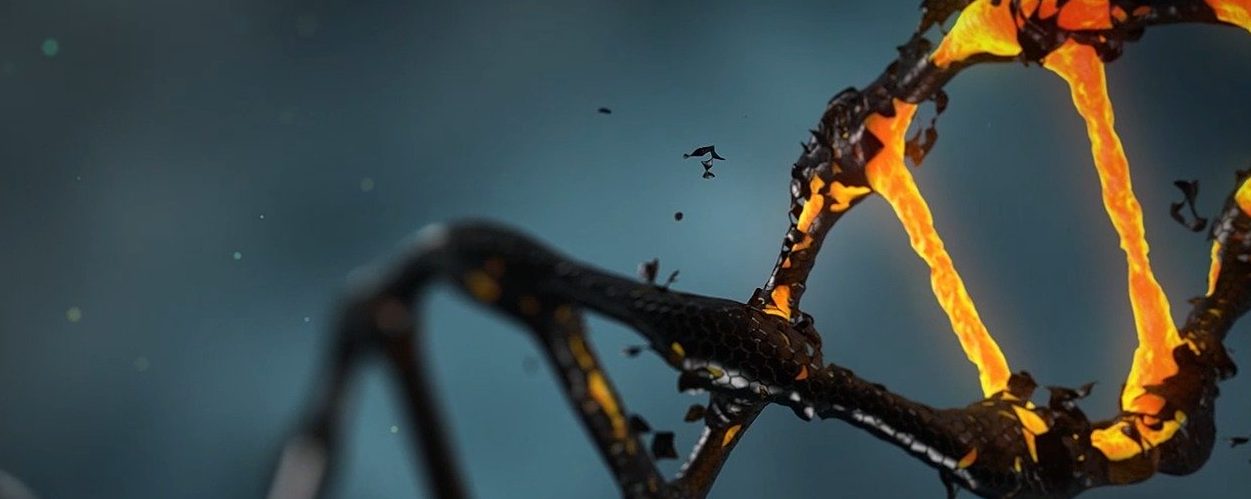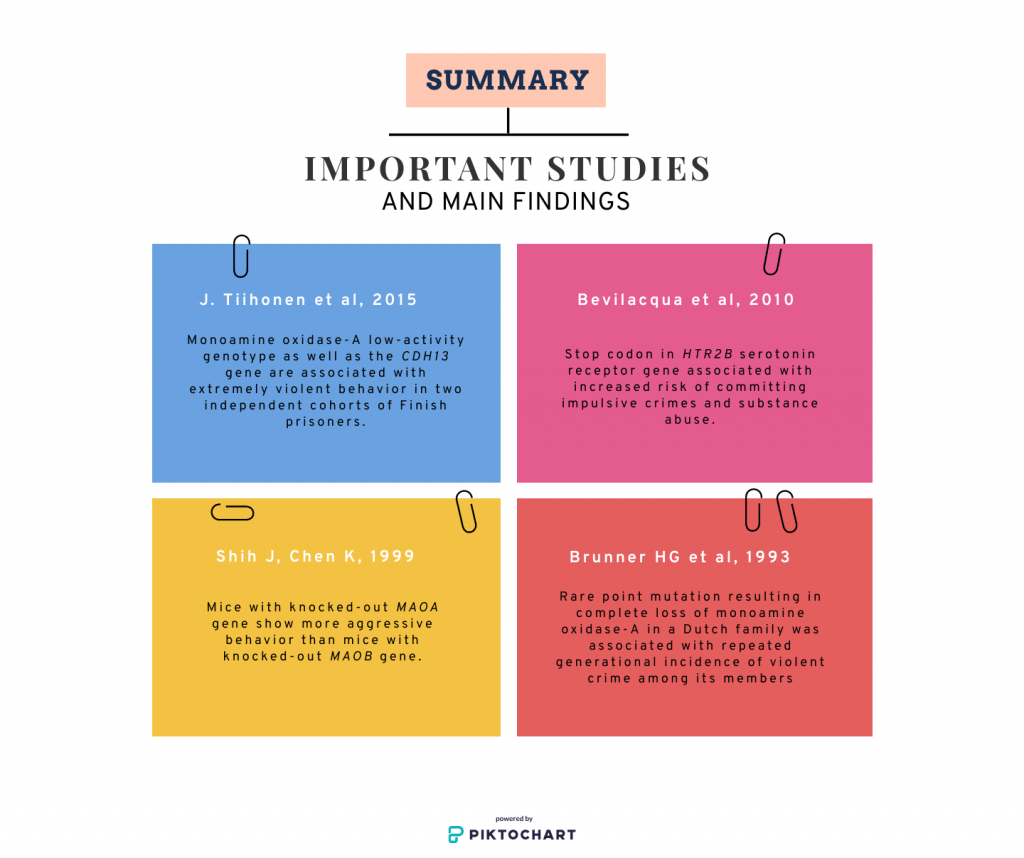By Anusha Subramanian
All the way back in 2010, an Italian judge made legal history by decreasing the already reduced sentence of a male convict accused of murder, after the convict was found to be a carrier of genetic variants that were thought to be associated with a predisposition for aggression (Forzano et al., 2010). The convict’s sentence was reduced prior to this intervention because he had schizophrenia and was actively psychotic at the time of the crime. However, at the appeal’s court, the defense was allowed to conduct a ‘genetic susceptibility test’ showing that the convict carried certain variants for the MAOA, COMT, SCL6A4 and DRD4 genes, that have been associated with aggression modulation, which later led to a modified sentencing from 9 years to 8 years.
Behavioral psychology, as a field, has always been intrigued by the etiology (the set of causes and manner of causation of a disease or condition) of violence. The landmark Italian sentencing came at a time when the social landscape was rife with studies linking genetics to a predisposition to violence, aggression, impulsivity, etc. and how such effects were compounded by environmental factors such as substance abuse and childhood malnourishment. Mednick et al. (1984) conducted a classic study showing the significant correlation between biological parents and adoptees for property crimes but not violent crimes. Much of the genes involved in serotonin pathways, such as SCL6A4, have been studied for their implication in impulsivity and substance abuse. Serotonin is a neurotransmitter that has been previously implicated in many functions including mood regulation and firing of the amygdala in the frontal lobe of the brain. For instance, the HTR2B gene encodes one of the several receptors for serotonin. In 2010, Bevilacqua et al found that a codon in the HTR2B mRNA that signaled the termination of translation (also known as the stop codon) was associated with substance abuse and increased risk of committing impulsive crimes like homicide, arson, etc. But a lot of research on this topic is complicated since the researchers were unable to prove whether the functional variant of HTR2B, i.e a form of the gene that alters its function, was associated with substance abuse, or impulsivity. In other words, no conclusions could be drawn about whether the gene caused a predisposition to substance abuse which then led to impulsive, crime-causing behavior or if it caused a predisposition to impulsivity which led to the cascade of substance abuse and criminal behavior — a problem involving what is known as the “direction of causality”.
And then we also have the MAOA gene, our star-player. Commonly known as the ‘warrior’ gene, MAOA has a complicated heritage. The MAOA gene codes for the enzyme monoamine oxidase-A which plays a key role in the breakdown of neurotransmitters such as serotonin. Individuals with defects in the MAOA gene that are associated with a low dopamine turnover rate have been shown to be more prone to aggressive behavior than their counterparts. To study these interactions, scientists often use ‘knockout studies’ that involve mutating a gene of interest so that it’s knocked out (KO) and can’t function anymore. It helps observe what changes are produced when the gene of interest isn’t functioning correctly which might ultimately inform research on the role of that gene and conditions caused by it and subsequent treatments. Knockout studies of the MAOA vs MAOB (monoamine oxidase-B) enzymes in mice show noticeably different behavior based on whether oxidase-A or -B is knocked out. (Shih JC, 1999). The two enzymes preferentially oxidize different substrates and the consequent build-up of particular compounds when one enzyme is knocked-out is the likely reason for MAOA KO mice demonstrating aggressive behavior while the MAOB KO mice do not. A rare point mutation in the MAOA gene that resulted in a total loss of monoamine oxidase-A was found to be associated with the repeated generational incidence of violent criminal behavior among members in a Dutch family (Brunner HG et al, 1993). Meta-analytical studies have shown significant interactions between the low-functioning variant (causing loss or reduced function) of the MAOA genotype and childhood difficulties on subsequent antisocial outcomes (Byrd et al, 2014). However, the biggest study on this matter, which looked at over 4000 participants, was once again struck by the difficulty in determining causal direction (Haberstick BC et al, 2014). It could not establish that MAOA moderated the relationship between abusive childhood and antisocial behavior. Additionally, most research in this field has been conducted on a sample of only males. Thus, research on the MAOA gene has been fraught with controversy.
Around the same time, it had been established that a large proportion of violent crime in developed countries was committed by a relatively small group of antisocial, repeat-offenders. In 2015, Jari Tiilhonen, currently a Professor in the Department of Clinical Neuroscience at the Karolinska Institutet in Sweden, and his colleagues, conducted a pioneering Genome-wide association study (GWAS) on the genetic predispositions to violent behaviors and repeat offenders in a cohort of Finnish prisoners. They had two groups – violent, which had at least one violent crime conviction such as homicide or manslaughter, and extremely violent, which had at least 10 violent crime convictions). ‘Extremely violent’ group was a subset of the ‘violent group’. Prisoners from 19 of the largest prisons in Finland, excluding diagnosis of some psychosis and convictions of sexual crime, were involved in the study. It was found that the low-activity MAOA genotype was associated with violent offending. Interestingly, findings did not differ between males and females and more importantly, the risk was not influenced by childhood maltreatment as some previous studies had suggested. The association was even stronger for the extremely violent group. In the extremely violent group, an additional strong association was found in a SNP (single nucleotide polymorphism) in the CDH13 gene that codes for neuronal membrane adhesion. CDH13 codes for the t-cadherin protein that has a role in proliferation, migration, and connectivity of neurons. Disturbed neural connectivity and CDH13 have been implied to be associated with Attention Deficit Hyperactivity Disorder, or ADHD, and it’s worth noting that one of the core symptoms of ADHD is often acknowledged as impulsivity.
At this point, it’s important to ruminate over a few key points regarding this Finish Prisoner study. Of the crimes committed by the offenders in the cohort, most were non-premeditated, which means that the crimes weren’t pre-planned. Therefore, in a way, the study almost exclusively focused on a definition of violence whose major attribute was ‘impulsivity’. In theory, there could be different types of violence (for instance, sexual violence, which this study excluded*) that could be governed by a different genetic recipe. A majority of the crimes in Finland are also committed under the influence of substances such as alcohol, which leads to a short-lived spike in dopamine levels. Another finding from the study suggested that the risk allele (low-activity variant of MAOA gene) could pose a genetic risk of developing alcoholism, but only in situations wherein the individual was exposed to a stressful childhood environment, such as childhood maltreatment, trauma and such. The study eventually concluded that about 9-10% of violent crime in Finland was associated with the low-activity MAOA allele. This is the point where the line between the responsibility of scientific results and their ethical application to the justice system, becomes significantly blurry.
Going back to the age-old Nature vs Nurture debate, a good way to think about it is that genetics provide an individual with a spectrum and the individual’s environment, developmental and otherwise, determines where you lie on it. A predisposition may lie dormant for eternity, but feed it a stressful environment and increased risk factors such as malnourishment and trauma, and it will manifest. Clinical facts must be tempered with ethical concerns when applying science to society. The Italian judge who reduced a sentence based on a genetic susceptibility test that is not grounded solidly in an environmental context may have set a precedent that does more harm than good in the long run. Their decision raises questions, such as whether propensity for violence could be accurately considered a mental illness. These questions require nuanced answers that we may not always be able to provide. Over-emphasizing the role of genetics in criminal behavior might lead to over-punishment or over-justification (Forzano et al, 2010). Genetic susceptibility may also lead to mitigation of responsibility in convicts during trials of offenses, leading to reduced punishments. MAOA and CHD13 are sometimes called “serial killer genes.” If we proceed to label people as “serial killer gene” carriers we risk stigmatization at unprecedented levels. Labels can lead to wide-spread discrimination, genomic-profiling, blurred social-equality norms, and resultant increased punishment without provocation. And the authors of the landmark Finish prisoners study also acknowledge that. In their own words,
‘It is equally important to realize that, according to the basic principles of forensic psychiatry, only the actual mental capability (phenotype) of the offender matters when punishment or legal responsibility is considered, and the putative risk factors per se (such as genotype) have no legal role in the resulting judgment.’
While I don’t know if there is a right answer to the question of how much we should factor genetics into our justice system, that cannot be the reason to stop debating the pros and cons of it. While modern civilization moves forward, facilitating dialogue, discussion and more research into the etiology and complex interactions of human behaviors in the context of our social systems will be vital to our progress as mankind.
References
FORZANO, F., BORRY, P., CAMBON-THOMSEN, A., HODGSON, S. V., TIBBEN, A., DE VRIES, P., VAN EL, C., & CORNEL, M. (2010). Italian appeal court: a genetic predisposition to commit murder? European Journal of Human Genetics, 5, 519.
Mednick SA, Gabrielli WH, Hutchings B. Genetic influences in crime convictions: evidence from and adoption cohort. Science 1984; 224:
Bevilacqua L, Doly S, Kaprio J, Yuan Q, Tikkanen R, Paunio T et al. A population- specific HTR2B stop codon predisposes to severe impulsivity. Nature 2010;
Shih J, Chen K. MAO-A and -B gene knock-out mice exhibit distinctly different behavior. Neurobiology. 1999;
Brunner HG, Nelen M, Breakefield XO, Ropers HH, van Oost BA. Abnormal behavior associated with a point mutation in the structural gene for monoamine oxidase A. Science 1993;
Byrd AL, Manuck SB. MAOA, childhood maltreatment, and antisocial behavior: meta-analysis of a gene-environment interaction. Biol Psychiatry 2014;
Haberstick BC, Lessema JM, Hewitta JK, Smolena A, Hopferb CJ, Halpernc CT et al. MAOA genotype, childhood maltreatment, and their interaction in the etiology of adult antisocial behaviors. Biol Psychiatry 2014;
Tiihonen, J., Rautiainen, M. R., Ollila, H. M., Repo-Tiihonen, E., Virkkunen, M., Palotie, A., Pietiläinen, O., Kristiansson, K., Joukamaa, M., Lauerma, H., Saarela, J., Tyni, S., Vartiainen, H., Paananen, J., Goldman, D., & Paunio, T. (2015). Genetic background of extreme violent behavior. Molecular psychiatry, 20(6), 786–792. https://doi.org/10.1038/mp.2014.130

